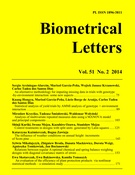
Biometrical Letters Vol. 51(2), 2014, pp. 153-170


|
BIOMETRIC CHARACTERISTICS OF INTERSPECIFIC HYBRIDS IN THE GENUS SECALE
Sylwia Mikołajczyk1, Zbigniew Broda1, Danuta Mackiewicz1,Dorota Weigt1, Agnieszka Tomkowiak1, Jan Bocianowski2 1Department of Genetics and Plant Breeding, Poznań University of Life Sciences, Dojazd 11, 60-632 Poznań, Poland, e:mail: sylviam@up.poznan.pl 2Department of Mathematical and Statistical Methods, Poznan University of Life Sciences, Wojska Polskiego 28, PL-60-637 Poznań, Poland, jboc@up.poznan.pl |

Breeding work using European rye populations has resulted in a considerable reduction of genetic variation in breeding materials of that species. Many taxa from the genus Secale may constitute a potential source of genetic variation in rye breeding. A source of new genetic variation can be found in such species as Secale montanum and Secale vavilovii, which are sources of resistance to fusarium ear blight and septoria leaf blotch, while Secale vavilovii may also be a source of sterilising cytoplasm. The aim of this study was to assess the efficiency of crossing the wild species Secale vavilovii and the rye subspecies Secale cereale subsp. afghanicum, Secale cereale subsp. ancestrale, Secale cereale subsp. dighoricum, Secale cereale subsp. segetale with the crop species Secale cereale ssp. cereale, and to produce F1 hybrids and describe selected morphological traits. Observations of biometric traits indicate that the F1 crosses produced may be potential sources of variation for common rye. The greatest variation in terms of all analysed phenotypic traits combined was found for the cross combinations S. c. ssp. cereale cv. Amilo × S. c. ssp. ancestrale and S. c. ssp. cereale cv. Dańkowskie Diament × S. c. ssp. dighoricum. The hybrids showed considerable variation in the analysed biometric traits within individual cross combinations.

Secale genus, interspecific crossing, biometrical traits, F1 hybrids
